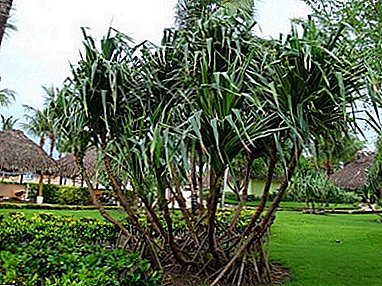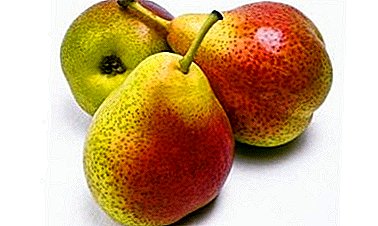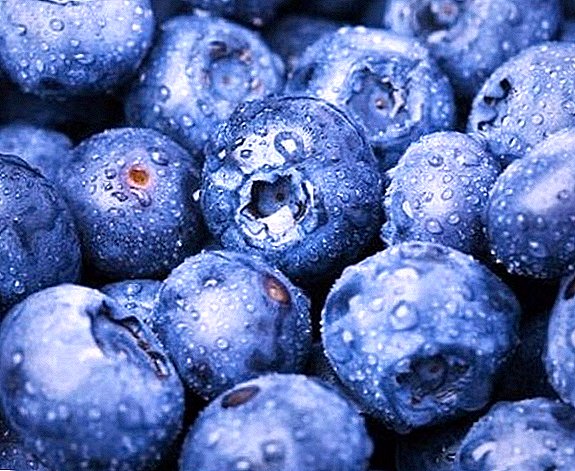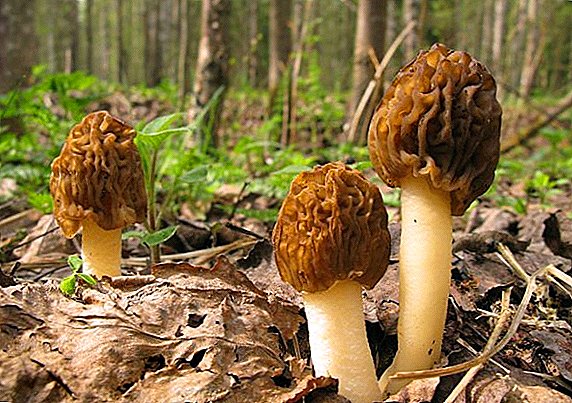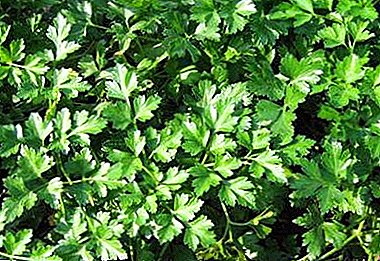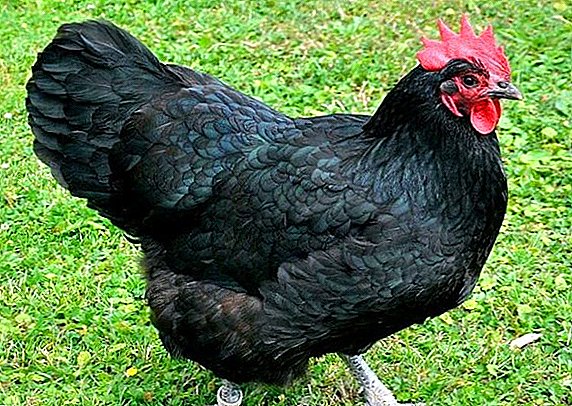 Chickens in home gardens - a pledge of fresh homemade eggs and high-quality meat products. Due to its high performance, the Australorp breed is especially popular among poultry farmers. What signs of pedigree should pay attention when choosing chickens and how to grow a healthy bird with maximum efficiency, we will describe later in the article.
Chickens in home gardens - a pledge of fresh homemade eggs and high-quality meat products. Due to its high performance, the Australorp breed is especially popular among poultry farmers. What signs of pedigree should pay attention when choosing chickens and how to grow a healthy bird with maximum efficiency, we will describe later in the article.
History reference
The beginning of a new breed of chickens was laid in the 1820s by Australian farmers William Cook and Joseph Partington. Breeders sought in the shortest possible time to bring early ripened birds with high rates of egg production and high-quality meat. 
The success of this venture brought the crossing of English black Orpington, Minorca, Kroad-Langshan and White Leggorn.
Did you know? Today, the United States of America is the largest producer of chickens on the world market, with an annual rate of 18.29 million tons. The top three are Brazil (13.6 million tons) and India (4.2 million tons).
The way to Australorps from their native Australia to other continents was slow and uncertain. Initially, many considered them the Australian variety of British orpingtons, as evidenced by the name of the breed, consisting of parts of the words "Australia" and "Orpington."
The little-known breed was readily accepted only in the USA. And when in 1922 the hens headed the world rating of egg production, they were talked about in Europe. Each owner of a big chicken farm and a tiny backyard yard wanted to have a chicken that could, without special lighting and feed impurities, carry over 300 eggs a year. 
The emergence of Australorps in European territory prompted local breeders to improve the breed. As a result, it was not possible to improve the taste of meat, precociousness or egg production of poultry. But her average weight decreased by 1 kilogram.
Did you know? The largest breeding breeds of chickens weigh no more than 5 kg, and the smallest (dwarf) varieties barely weigh up to 500 g.
Description and Features
Australorpas are a meat-egg breed of chickens that is easily distinguished by certain characteristics.
Check out the best meat and egg breeds of chickens, as well as find out which breeds belong to meat and which ones belong to egg.
Let's take a closer look at what indicates the pure blood of the hens and roosters, and what the standard does not allow.
Exterior
Common signs for males and females are the average size of a dense body and lush plumage. 
Roosters are peculiar to:
- small head;
- straight leaf-shaped comb with five teeth of regular shape (its end follows the line of the occiput);
- wide chest;
- deep belly;
- wings with wide, close-fitting feathers to the body;
- medium leg length with a wide supply and black or black-gray color (the sole is light);
- lush tail with many crescent feathers.
- black beak and eyes;
- red lobes and earrings;
- White skin;
- lush loose plumage with emerald sheen, dark down.
Distinctive features of pedigree chicken are:
- smaller body size;
- small scallop with wide teeth and short toe;
- broad tail at the base of moderate length;
- blue-black metatarsus.

The exterior of newly hatching Australorp chicks is characterized by clear ashy and straw markings on the black wings and abdomen. But here it is necessary to show special observation and patience. After all, the breed is characterized by late culling. Chicks often have white fluff, bright eye iris and metatarsus.
With age, these signs darken and the chicken in question begins to fully comply with the signs of pure blood.
Important! For Australorps, red or pale eyes, elongated teeth on the crest, too small, narrow and shortened body, as well as an excessively long tail with purple and golden tints are unacceptable. Such breeds standard breed rejects.
Character
Representatives of this type of poultry do not like noise and excessive activity. They are very balanced, calm and non-conflicting. They are characterized by phlegm. Roosters will not be avid fighters, and hens will not pry out of their affairs. 
They make good hens. This is not a living creature that will, without reason to stand on the wing and cluck. In the conditions of home cultivation australorp comfortable and obedient.
Hatching instinct
According to the poultry farmers, the breed is characterized by a high incubation instinct, which increases the percentage of hatching, displacing the brood sex ratio in favor of females.
Learn how to get the young by natural incubation of eggs and with the Perfect Hedge Incubator, as well as the proper way to grow chickens.
Many australorp chickens sometimes switch to hen status over the summer, breeding 10-15 chickens each. That is why experienced hosts recommend collecting eggs for roost.
For the formation of the family, only purebred birds are allowed: a late-ripe rooster with clear signs of the breed and about 15 chickens. At first, it is important to watch the pack, as the males are very heavy and apathetic. With low fertilization, they should be replaced by other males up to 5 years old. 
It should be borne in mind that such instincts are directly affected by the mode of cold and heat. According to experts, nestlings overheated with artificial lamps will develop prematurely, but in this case you should not count on good progeny.
Important! In order to choose the right number of chickens and males from the flock of australorp chicks, pay attention to the earrings and scallops. In males, they are more pronounced, differ in a rich pink color. They also give out massive legs.
Varieties
When the founders of the australorps, William Cook and Joseph Partington, began their breeding work, they had clean-black chickens with a noticeable dark green glow. Such specimens have long been considered thoroughbred. But soon the world recognized other species of the breed. We learn in more detail which ones.
The black
To this day, American farmers vehemently uphold the standard of exclusively black birds. 
It is the most popular in other continents. Poultry breeders love such chickens for impressive weight, since other colored Australorpes are much smaller.
Moreover, the location of the poultry farmers this species has won its resistance to common avian diseases (in particular, pullorosis). In addition, black layers produce up to 220 eggs per year.
They reach their sexual maturity at the age of 5.5 months and by that time already weigh about 2.9 kg. The weight of adult cocks reaches 3.9 kg.
Did you know? The Chinese traditionally paint the eggs red every time a newborn appears in the house. It is believed that this symbol of life will give the baby good health, a long and happy life.
Marble
This variety is popular only because of the spectacular blue plumage. Birds stand out with a dark border on the legs and breast. But such chickens weigh in the range of 2.2-2.6 kg. 
They have lower immunity and much worse egg production.
The last years of painstaking selection work have allowed a little to enlarge the egg obtained from the marble layer. Now it weighs about 55 g.
These are the main varieties of australorps. Some poultry farmers at the amateur level emit white, dark yellow, golden, wheat-laced, pockmarked and even motley species. The greatest variety of breed standards are currently in place in South Africa. They even distinguish dwarf representatives of the breed.
Productive qualities
Experts evaluate the Australorps as a highly productive and very hardy poultry.
Learn also about the productive qualities and characteristics of the content of such breeds of chickens as Barnevelder, Orlovskie, Welsumer, Jersey giant, Brama, Poltava, Kuchinskaya anniversary, Rhode Island, Russian white, Indokury, Adler silver, Bielefelder, Brekel silver, Hubbard.
The conclusion was made on the basis of a deep analysis of egg production and taste qualities of the meat of mature individuals. 
Annual egg production
Neither the season, nor the weather conditions, nor the artificial illumination affect the productivity of the hens. They give eggs all year round. And if in 1922, American experimental farmers managed to collect more than 300 eggs from one hen in a year, today this figure will start at an average of 200 pieces.
Learn how to increase egg production in chickens in winter, what vitamins are needed for laying hens for egg production, when young pullets begin to rush, and why chickens do not carry eggs, why chickens carry small eggs.
Each of them has a pleasant creamy-brown shell color and weighs between 55-62 g, depending on the Australorp variety.
Chickens start sweeping with 135 days of life. Note that since the age of two, egg production rates are beginning to decline. Therefore, experienced farmers advise the timely replacement of the herd.
Important! The survival rate of australorp chickens is 95%. From an adult herd, only 12% of chickens die.

The taste of meat
Since the creators of the breed set a goal to create early-ripening birds, the Australorpos gain maximum body weight by the age of 8 months. The average black rooster will hang in the range of 3.6-3.9 kg, and the chicken, respectively - 2.7-2.9 kg. Dwarf individuals more than 1 kilogram will not gain weight.
The meat of this bird is distinguished by its juiciness and pleasant taste. Experienced housewives say that the presentation of the carcass often spoil the dark pads of plucked feathers. Therefore, for aesthetic reasons, it is better to slaughter chickens after molting.
Conditions of detention
Breeding this type of poultry will not bring much trouble, will not take much time and will not require financial expenses. In the maintenance and care of Australorpa very undemanding and hardy.
They will be satisfied with the conditions traditional for any kind of hens. Let's take a closer look at the nuances on which the health and development of feathered wards depends. 
Coop Requirements
The construction of chicken housing does not deviate from traditional standards. If necessary, the walls of the structure must be insulated. In winter, the temperature in the room should not fall below 12 ° C.
Of course, if it is lowered to 0 ° C, the tenants will not die, but such a drop will have a detrimental effect on bird productivity. If the chicken coop is not heated, install infrared lamps or oil radiators in a timely manner.
It will be useful for you to learn how to choose a chicken coop, how to build a chicken coop with your own hands, how to equip a chicken coop, how to build a chicken coop for the winter for 20 chickens, how to make a chicken nest with your own hands, how to make ventilation in a chicken coop.
The inner filling of the enclosure as well as in other species of birds, includes the presence of perches, nests, feeders and drinkers. It is desirable that they were made of wood. In this regard, any configuration is allowed.
The breeder must ensure that no more than 4 chickens per square meter in the cage per square meter. 
When ground maintenance, be sure to cover the floor with straw or sawdust. Alternatively, a mixture of peat and wood chips. The last option is relevant for winter time, because it will serve as an additional floor insulation.
Important! Do not forget that, according to sanitary standards, the house should be regularly ventilated.
Courtyard for walking
All chickens for a full development requires a certain walking territory. It should be fenced from above and from the sides in order to block the exit of the bird beyond the designated area. Its size should correspond to the number of individuals and not hamper their movement.
This yard must be sown with grass for grazing. Chickens love clover, lawn mixture, mustard, knotweed, barley. At the same time leave the ash zone, where the birds will take bath procedures. 
For this they need a mixture of equal parts of wood ash, river sand and fine granotsev. This is a natural cleaning of birds from sucking parasites.
How to endure cold
Due to abundant plumage, these people from hot Australia react adequately to high and low temperatures. In winter, they do not suffer from cold and often go for a walk, even when other breeds prefer to sit in the warmth. Such weather conditions do not affect the laying of eggs, they continue to rush in severe frosts.
However, according to experts, do not abuse the Australorp endurance to the cold. Optimum temperature for their full development - 12-15 ° C. It is important to ensure that the light day for mature individuals lasts no more than 15 hours.
Did you know? The smallest bird in the world at a hummingbird, its diameter is 12 mm, and the largest at an ostrich, 15-20 cm. Hen, Harriet decided to fray with an ostrich, and in 2010 she laid an egg that fell into the Guinness Book of Records - 23 cm in circumference, 11.5 cm in length and weight just over 163 grams.

What to feed adult chickens
Compared to other meat and egg breeds of chickens, the Australorps are less voracious. But they compensate for this good quality with high demands on everything that falls into their feeder. If there is a shortage of any trace elements in the diet of the female, she will begin to produce soft eggs without a shell.
Check out what the diet of chickens should be and how to feed laying hens.
In addition, unbalanced nutrition will result in a decrease in egg-laying rates. Therefore, feeding needs a serious approach.
To grow healthy chicken, experienced farmers advise you to observe the following rules:
- Adults feed the grain, as well as boiled vegetables, herbs, bran, meat and bone meal, dairy products and fish waste. These ingredients can be given in pure form or in mixtures.
- Be sure to add yeast to chicken food weekly. This trick will increase laying egg production.
- Do not neglect the additions of chalk, ash, shell, gravel and shells. Such nutrients improve the processes of digestion of birds.
- Every summer, harvest hay for chickens. In the winter, it is ground to a state of flour and mixed into food. Also, silage and pulp will not be superfluous.
- Teach the bird to the daily walking. Herbal is needed for a balanced diet. Moreover, it is a source of necessary insects and soil worms.

Did you know? TOItians have learned how to make authentic chicken eggs by hand. The shell they are made from calcium carbonate, and for yolk and protein, respectively, use gelatin stained with food impurities.
Breeding chicks
In most cases, the breeding of Australian chickens occurs in incubators.
It will be useful for you to learn how to make an incubator from an old refrigerator, about the advantages and disadvantages of incubators such as Blitz, Cinderella, and Layer.
But at home, you can get strong pedigree chicks.
Egg Incubation
Even novice poultry farmers know that not all eggs are suitable for incubation. Before laying each of them need to double-check the weight and quality of the shell. Specimens with spots and spots on the surface, outgrowths, depressions and cracks are rejected, since these defects hinder the full development of the embryo.
The selected ten must be disinfected with a swab moistened with a solution of potassium permanganate. 
Experts note that at home, there are large errors in the temperature regime of the incubation period. If you use domestic incubators, be sure to maintain the required level of humidity with the help of tanks with warm water.
This indicator should correspond to 60-63%. Before laying the eggs that were kept in a cold room, be sure to warm them for 6 hours, which will allow the whole brood to appear at the same time.
It is important to monitor the temperature of artificial incubators. After all, in case of overheating, chickens will spawn quickly, but they will be small. If the eggs are underheated, the umbilical cord will not grow in the brood. Remember that the process of maturation of the embryo must occur naturally, without third-party intervention.
Important! Eggs for further incubation should be stored vertically, with blunt ends up. It is desirable that this was a cool room with a temperature of 12-17 ° C and humidity of 80%. The maximum periods of such storage should not exceed 1 week.

Experts identify 4 stages in incubating chicken eggs:
- The first 7 days after laying, when the active formation of the embryo begins.
- The next 4 days, when dry air is not allowed. It is important during this period to monitor the level of humidity in the room.
- It lasts from the 12th day of egg laying in the incubator (or under the hen) to the first sounds of hatchlings that have not yet hatched. Then metabolic processes are activated and gas exchange occurs.
- The finale, when the chicken is born.
In general, the incubation of eggs of Australian chickens lasts for 20-21 days. Hatching chicks must be carefully examined: healthy individuals should have clear and protruding eyes, a short beak, a soft umbilical cord, and no sagging belly. 
Care for the young
In the first 10 days of life, the brood requires special attention and care. Надо заблаговременно позаботиться о теплом, сухом и чистом помещении - без сквозняков, но с хорошей вентиляцией. Правильно рассчитывайте площадь.In the home corral enough to provide a separate platform for hen with chickens.
If australorps are grown on an industrial scale, then on one square meter, plant no more than two dozen chickens. After a month and a half, they will need to be divided into separate compartments of 17 heads, and after 12 weeks - 10 individuals per square meter.
Did you know? Oddly enough, but the creator of horror, the famous film director Alfred Hitchcock was afraid of eggs to tears. In psychiatry, such a fear is indeed recognized and is called ovophobia.
In the first 3-5 days of domestic chicken it is better to keep in a spacious wooden box with a barred top. Bottom must cover paper. 
Sawdust and hay are not suitable, as they can damage chicks. Above, you can pour a little cornmeal or millet - living creatures will be willing to fumble there in search of food.
Remember that in the first months of life, little australorps especially need warmth. Brood death is possible even at room temperature. Therefore, strictly make sure that in the first week the air in the room where the chickens live is heated to 29-30 ° C. In the future, the temperature can be reduced to 26 ° C.
At the age of one month, chickens feel comfortable at 18 ° C, but the temperature should be reduced in stages every week (by 3 ° C).
Experienced farmers advise using infrared lamps for heating brood at night and in bad weather, and in the afternoon, from three days of age, take out the chickens in the sun. For walking, even with a hen, such animals should be tamed gradually. 
Chicken Diet
The peculiarity of the little australorps is miniature and fragility. But every day their body develops rapidly, demonstrating good health and high potential for survival. If young animals are provided with good food and fresh drinking water, by 2 months they will gain up to 1.5 kg of weight.
Learn how and how to feed the chickens, how to feed the broiler chickens, how to prepare feed for chickens.
Here are the basic principles of balanced nutrition of Australian chicks:
- The first 10 days of life youngsters need to feed a mixture of boiled eggs, cereals and finely chopped greens.
- In the future, the egg component is completely excluded from the diet, replacing it with feed, which includes a lot of proteins.
- During the entire period of growing chickens, the basis of their daily diet is grain. It is mixed with greens and fish oil (the last ingredient is calculated at a dosage of 1 g per day for each individual).
- Boiled root vegetables are also important, and from 2 months of age they can be mixed in raw.
- Every day, change the water in the watering poultry.

Did you know? Until now, no one has managed to break the record set in 1910 in the United States by an unidentified man who ate 144 eggs at a time. The current record holder Sonya Thomas did not reach up to half - she managed to eat only 65 pieces, but much faster in six and a half minutes.
Herd replacement
The life expectancy of Australian chickens is quite high, which is associated with their resistance to typical diseases. But the laying ability of egg laying has been declining since the age of two. The older the hen, the less eggs she gives.
Therefore, the poultry farmers, wanting to get the maximum profit from breeding these chickens, every 2 years begin to smoothly replace livestock. 
Advantages and disadvantages
According to the poultry farmers who have experience in breeding Australorps and other breeds of chickens, this animal has many advantages.
Among them:
- low maintenance and high resilience;
- quick adaptation to any conditions;
- precociousness and high egg production rates (even in winter) and in the meat segment;
- peaceful nature and unpretentiousness.
Many owners believe that the breed is ideal and it does not have flaws. This can be questioned, since the Australorps, having a long history, occupy only a small share in the world chicken segment.
However, having studied the features of this species of birds, we did not find any serious flaws. 
The disadvantages that can deter farmers and amateur poultry farmers in breeding these chickens are:
- low productivity of mixed offspring - often crossbreeds are characterized by low rates of meat and egg productivity;
- in the poultry market, breeders are constantly offering new beef breeds with which the Australorp is hard to compete with.
If you do decide to start breeding this breed, be sure that it will not disappoint you. Australian chickens can provide you with not only nutritious and healthy meat, but also fresh homemade eggs. Moreover, the effort for this will require no more than when caring for other breeds of chickens.


